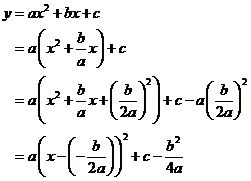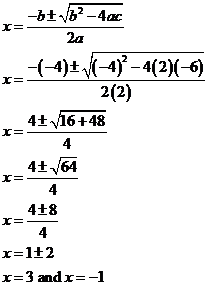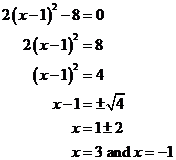

Assignment 2:
Investigating the Relationship between the Two Standard Forms of the Graph of a Parabola
y = ax2 + bx + c
y = a(x - h)2 + k
by
Ángel M. Carreras Jusino
Goals:
- Show the derivation of the equation y = ax2 + bx + c from y = a(x - h)2 + k and vice-versa.
- Show the relationship between the parameters involved in both forms of the graph of a parabola.
From y = ax2 + bx + c to y = a(x - h)2 + k
To derive y = a(x - h)2 + k from y = ax2 + bx + c we use the technique of completing the square.

Therefore comparing the two formulas we have that
![]()
From y = a(x - h)2 + k to y = ax2 + bx + c
To derive y = ax2 + bx + c from y = a(x - h)2 + k we need to expand the equation.
Therefore comparing the two formulas we have that
Now, how these information help us to understand better the standard forms of the graph of a parabola?
Lets see what type of direct information provides each form that the other does not provide and what advantages have one form over the other.
The form y = ax2 + bx + c provides the y-intercept of the graph, the point (0, c), and the quadratic formula is based in the values of a, b, and c to find the zeros of the graph.
Example. The graph of y = 2x2- 4x - 6 has y-intercept (0, -6) and using the quadratic formula its zeros are

The form y = a(x - h)2 + k provides the coordinate of the vertex of the parabola, the point (h, k), the symmetry axis, the line x = h, and the zeros of the graph can easily found by solving by x.
Example. The graph of y = 2(x - 1)2 - 8 has vertex on the point (1, -8), the symmetry axis is the line x = 1 and the zeros are

Note that both examples produce the same graph, now lets see how the information provided by one form can be gathered from the other.
- The form y = a(x - h)2 + k provides the coordinates of the vertex and the equation of the symmetry axis, information that y = ax2 + bx + c does not provide. From what was discussed at the beginning, when we were deriving the equations, we got that
.
Therefore from the values of the parameters a, b and c from the equation of the form y = ax2 + bx + c we can obtain the coordinates of the vertex (h, k) and the equation of the symmetry axis x = h.
- The form y = ax2 + bx + c provides the location of the y-intercept, information that y = a(x - h)2 + k does not provide. From the previous discussion of the derivation of the equations we got that c = ah2 + k. Therefore from the values of the parameters a, h, and k from the equation of the form y = a(x - h)2 + k we can obtain the location of the y-intercept (0, c).
In conclusion, from the two standard forms of the graph of a parabola can be gathered the same information after a little manipulation of the parameters.